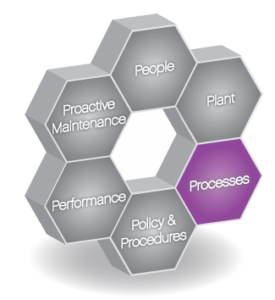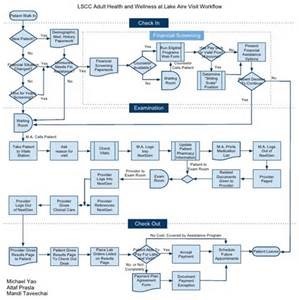Plant Hexcellence™ – Processes
 This is the third installment of six in the Plant Hexcellence exploration journey. The first two articles addressing both the “People” and the “Plant” cells with the corresponding facets.
This is the third installment of six in the Plant Hexcellence exploration journey. The first two articles addressing both the “People” and the “Plant” cells with the corresponding facets.
All of the cells are interrelated and that is what brings the Asset Management strategy full circle, but there are some facets that need to be discussed specifically and how they interrelate. We will be talking about Policy & Procedure in the next issue, but Processes have so much inter-dependency with that cell that it requires a brief discussion now. A Policy is a document set in place to create governance of a situation. A procedure is how personnel will execute accordingly to meet that governance. A process is a graphical representation, map or decision tree of the actual method to accomplish the procedure supporting the policy.
So what are work processes?
DEFINITION = A visual representation of Work depicted in flow diagrams. They demonstrate a mapped chronological path or alternate paths that are taken to accomplish a specific task.
They are also called Work-flow maps. Which processes should be mapped and which ones are we talking about relating to Asset Management? What is the importance of mapping the process?
When you take the time to map the process, it gives the end users the chance to look at:
- What actually occurs accomplishing the task (AS-IS)
- What could be the more/most efficient path (TO-BE)
- Whether there are alternate paths or methods to accomplish the task.
- What information must be available in order to make a decision to move to the next box/figure in the map
- What functionality is required by the work management system in order to follow the path or procedure?
- Verification of regulatory documentation of a specific path to meet the governance of the policy.
- Ability to assign roles and responsibilities specific to the tasks within the diagram.
The following section is an excerpt from Robert Boehringer, Vice President, Orion Development Group
To effectively visually represent a process, these critical dimensions should be included:
- Who
- What
- When
- Where
- Whether
- What Degree (how much)
- What Frequency (how often)
It sounds a little bit like “Journalism 101,” and that’s the point. Tell a visual story about your process and all possible solutions. When you add these dimensions you develop interesting characters and sub-plots which captivate your audience.
Who: Who does the work? Who authorizes the work? Who hands-off the work? Who verifies or changes the work? Keep asking why until you have considered all the stakeholders – the suppliers, the owners, the customers, the community, the employees, and the regulators (acronym: SOCCER). The “who” dimension shows opportunities to transfer work “to” or “from” your customer in order to simplify your process. Good map formats for this dimension include the Responsibility Matrix and the Swim Lane chart.
What: What work is being done? What work is not being done? What value-added transformation is happening, or what non-value-added work occurs due to functional silos? What waste occurs – rework or mistakes? The “what” dimension acts as the “verb” in your process map. Good map formats for this dimension include the Top Down, the Logic Flow, the Flow Process chart, the Swim Lane or the State Change Chart.
When: When is work done? Is it relatively before or after an event? Or does it occur on an ad-hoc basis? The “when” dimension provides movement, flow, or a feeling of a series of events. When work is happening serially, and you display it that way, you might find an opportunity to take advantage of parallelism – redesigning the work to happen at the same time. Good map formats for this dimension include the Logic Flow, the Work Flow Diagram, and the Swim Lane chart.
Where: Where is the work accomplished, physically? Which building, cubicle, floor, state, country, or area? The “where” dimension provides co-location opportunities which simplifies workflow. Good map formats for this dimension include the Work Flow Diagram and the Swim Lane chart.
Whether: Is this work that must be done or is it “nice to have?” What triggers this work being done? Someone or something determines whether or not to do the work. Seek to eliminate non-value-added intermediaries where decisions to do the work are separate from the participants who do it. In a simple process, the “whether” decision is made by process performers. The unneeded complexity can be simplified by evaluating the “whether” dimension. Good map formats for this dimension include the Top Down chart, the Logic Flow, the Flow Process chart and the State Change chart.
What degree (how much): How much of the process can one participant accomplish? What are the boundaries – in skill or in authorization? How much work needs to be done to achieve an acceptable level of performance? The “what degree” dimension reveals excessive standardization without regard for the participants involved. One solution includes using specialists in a team with broader responsibilities, thus simplifying the entire process. Another solution includes adding a caseworker between extreme specialists, to simplify customer service. Good map formats for this dimension include the Top Down, the Cycle vs. Process Time, the Flow Process Chart, and the Work Flow diagram.
What frequency (how often): How often is the work happening? What triggers the work – time passing or completion of another activity? The “what frequency” dimension reveals the “80/20 rule”: 80 percent of the time normal activities occur, but in the 20 percent of the time when exceptions occur, we spend 80 percent of our effort resolving. This dimension reveals your exceptions. Good map formats for this dimension include the Top Down, the Logic Flow, the Work Flow and the Cycle vs. Process chart.
(Process Management Memory Jogger, Robert Boehringer)
As it relates to Asset Management, some, but not all the processes that should be mapped include:
Operations
Startup and Shutdown. – More damage and equipment failure occurs during poorly executed start up and shut down than any other time.
Asset Management
Work – Any and all work related to equipment and facilities maintenance in the most efficient and effective manner.
- Work Identification
- Work Planning
- Work Scheduling
- Work Assignments
- Work Execution
- Work Closeout/ Audit
Parts – All inventory of MRO related parts to include consumables in the operational process
- Parts requisition
- Parts ordering
- Parts purchasing
- Parts being pulled from inventory
- Kitting of parts for work scheduled
- Adding parts to inventory as a permanent spare
- Max/ Min quantity and method of calculation
- Receipt of parts
- Inventory Cycle Counts tied to ABC methodology
- Regulatory Affairs
- Management of Change
- Permitting
- Hazardous work review
In summary, we have already addressed the People Cell (who executes the work), the Plant Cell (what work must be done and what to do it upon) and now Processes (how to execute the work). Stay tuned next post to look at Policy & Procedures.
The Plant Hexcellence Model is a proven model that was developed by Scott Kelley at Geometric Reliability but is the model of choice for Eruditio, LLC. If you are interested in the Plant Hexcellence model for your site or organization, please contact [email protected].
I’m James Kovacevic
Eruditio, LLC
Where Education Meets Application
Follow @EruditioLLC
References;
- Plant Hexcellence Model
- Free PDF Download on Plant Hexcellence – Process
- Scott Kelley
- Geometric Reliability
- The Benefits of Processes – Rooted In Reliability
- The Importance of an Asset Management Model – Rooted In Reliability
- The ABC’s of Asset Management – Rooted In Reliability
*This post was originally written by Scott Kelley of Geometric Reliability and modified by James Kovacevic

